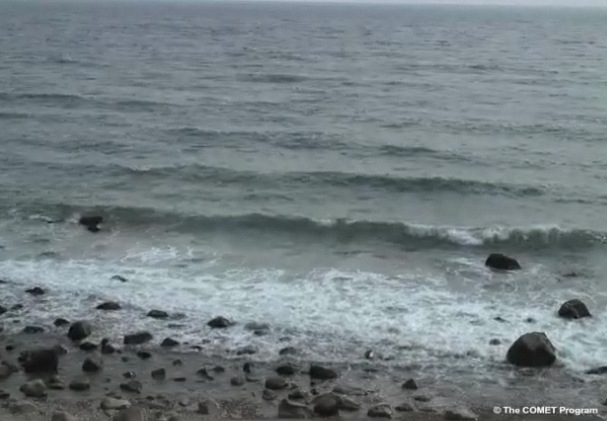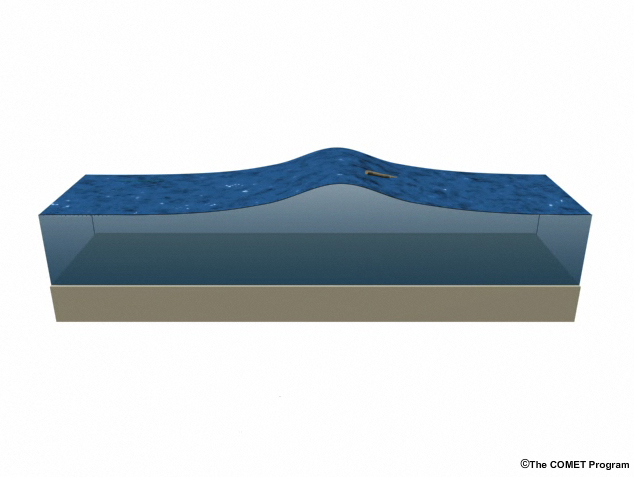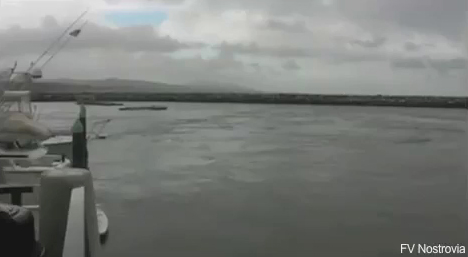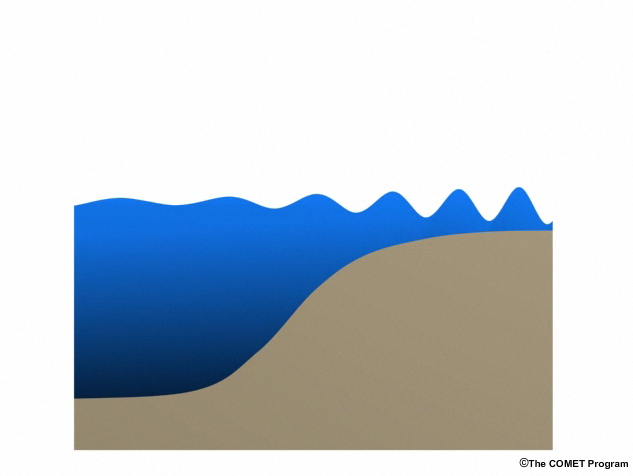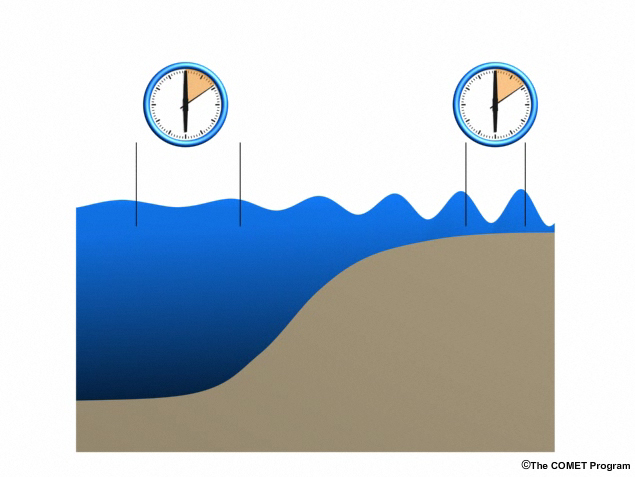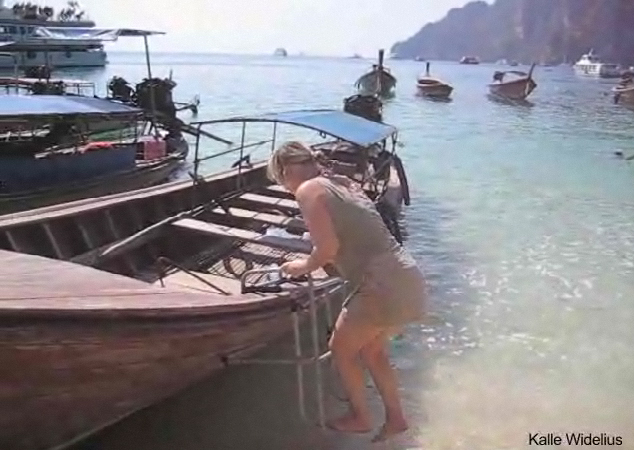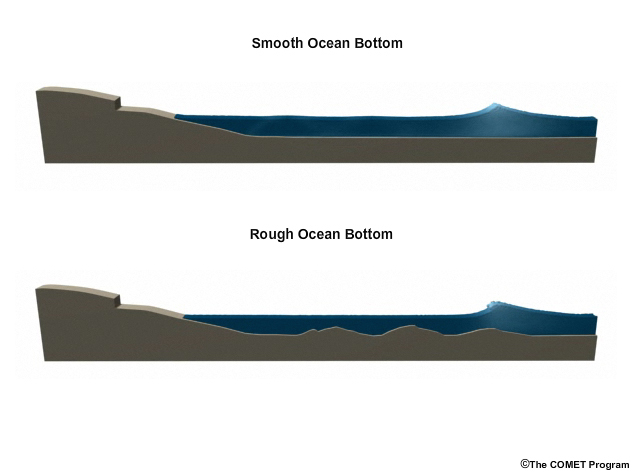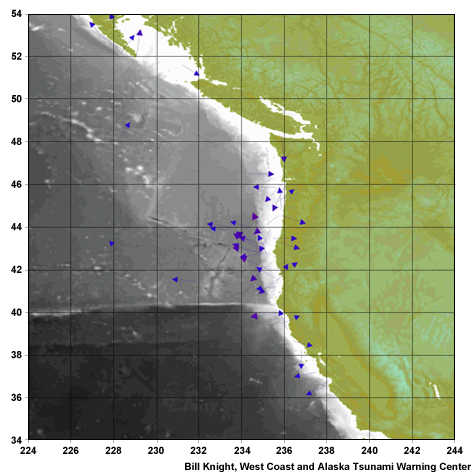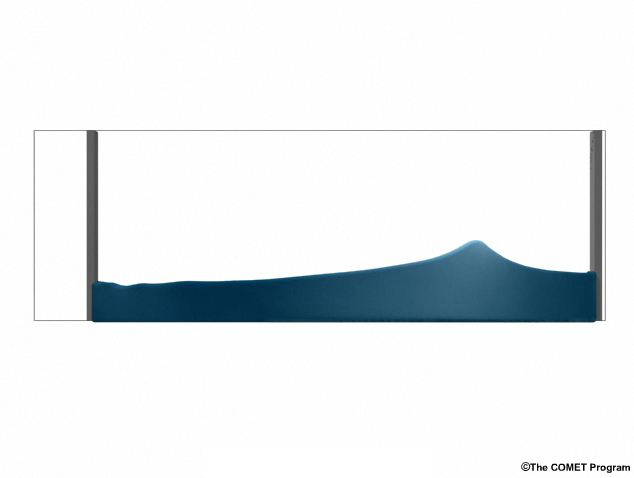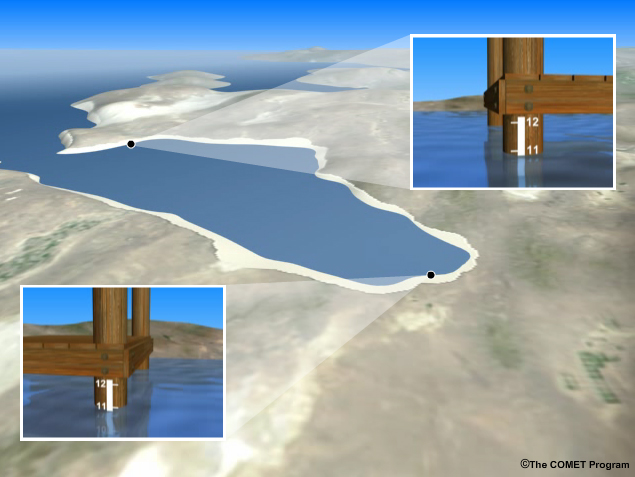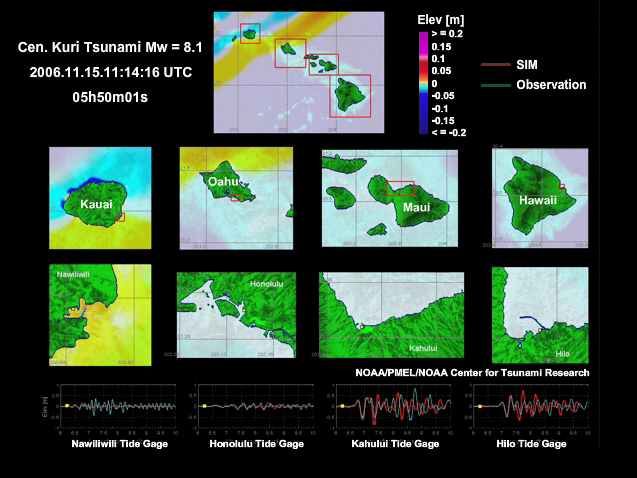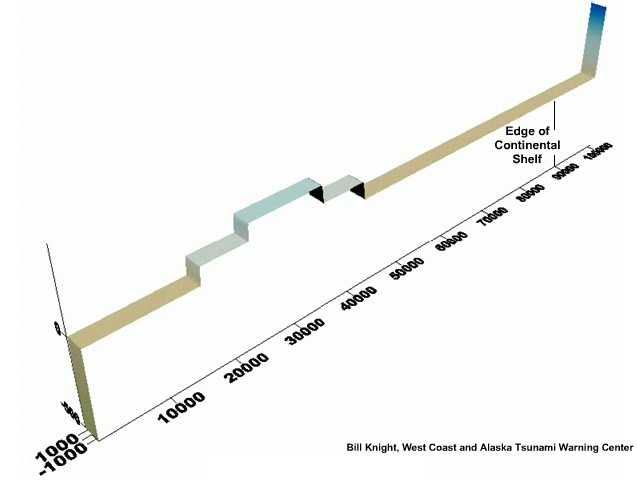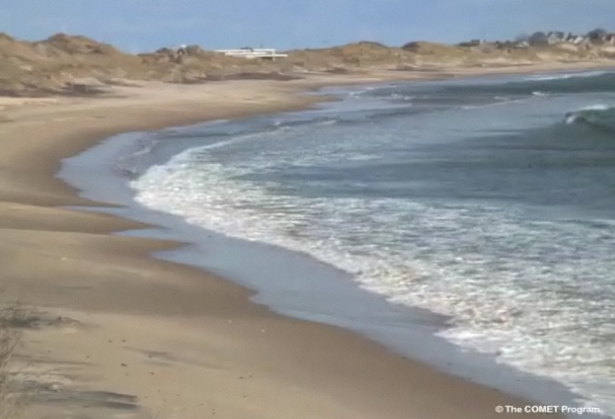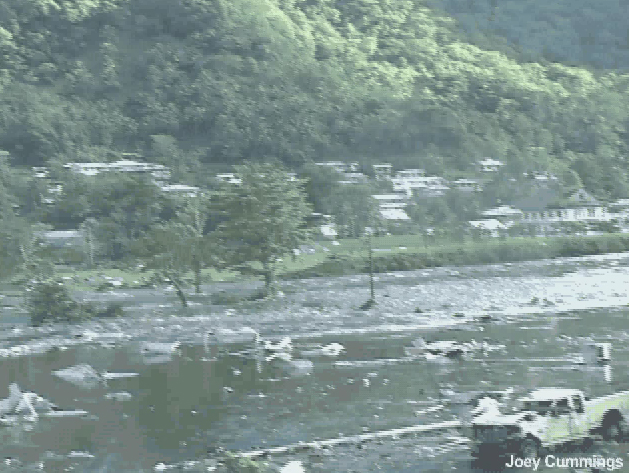Print Version
Inundation
Inundation
Wave Transition
Like all shallow water waves, tsunami waves undergo a transformation from a mass movement of energy to a mass movement of water as they near shore. At sea, boats or surfers may roll up and down on wind waves, but they are not carried inland by them. But in the surf zone, where waves break, surfers, swimmers, and anything else caught up in waves are pushed shoreward.
Current
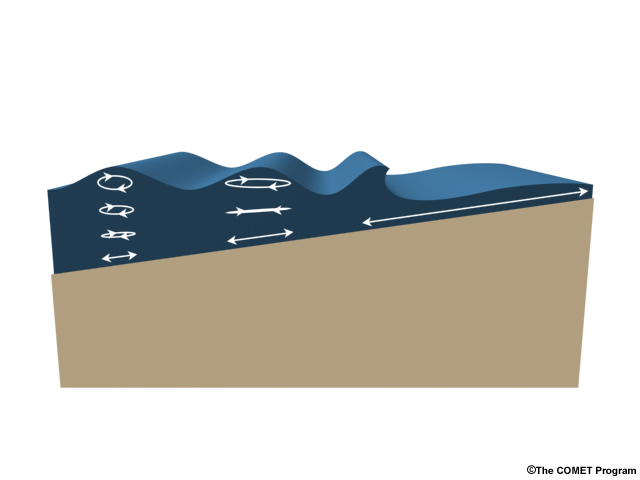
How does this transition occur? At sea, water molecules move in elliptical or circular orbits as waves pass by. Near shore, the water molecules start to move not simply in ellipses, but with a small net forward movement that increases the closer the waves come to shore. This is called “current.”
One way to think of current is from the perspective of a twig dropped in the water. Only when current is present would the twig experience net movement. Though friction contributes to this effect, the decreasing depth is mostly responsible.
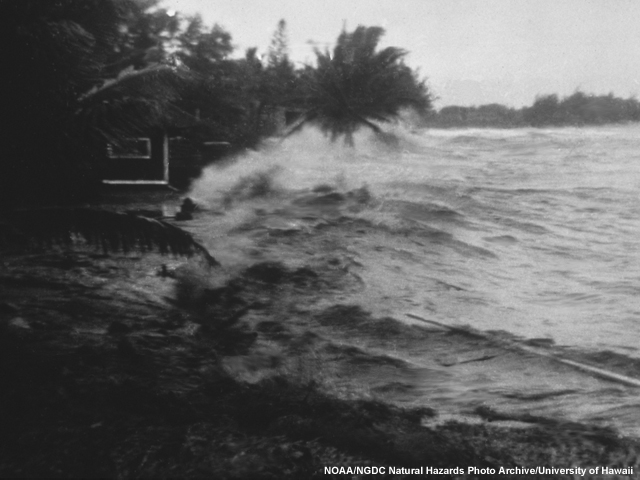
As waves draw nearer to shore, a net shoreward flow develops and current increases. By the time a massive tsunami has become a surging debris flow studded with trees, boats, and demolished houses, it's easy to see this. As tsunami currents reach their maximum velocity, any harbors in their path can become dangerous.
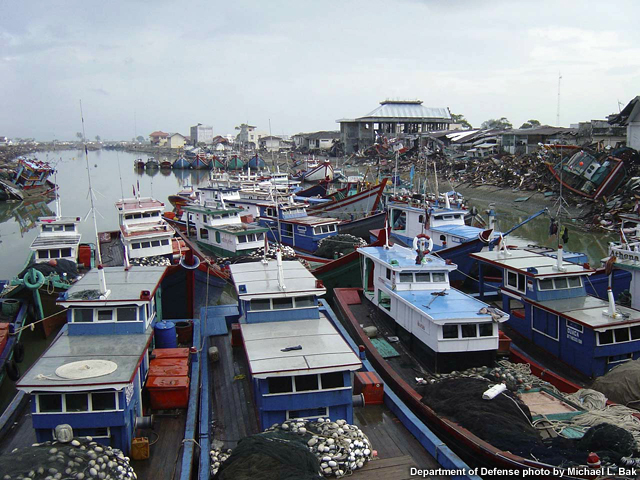
Docks heave and boats smash into each other, break their moorings, and become floating battering rams.
In addition, as a wave moves into shallower water, the rising bottom slows the wave and shortens its wavelength while increasing its height. Thus, as a tsunami wave moves into shallower water, the wave speed decreases while the current speed increases. When the tsunami surges over land, the two speeds equalize.
Constant Period
The period of a tsunami is constant for the first wave cycle. To review, the period of a wave is the time between wave crests. That property is conserved, even in shallow water, and even though the wavelength is shortening. Why? The wave speed is dropping at the same time the wavelength is dropping, and as a result, these effects cancel one another to give a period that is the same as in deep water.
Tsunamis at Shore
How do you think most tsunamis arrive at shore? (Choose all that apply.)
The answers are A, C, and E.
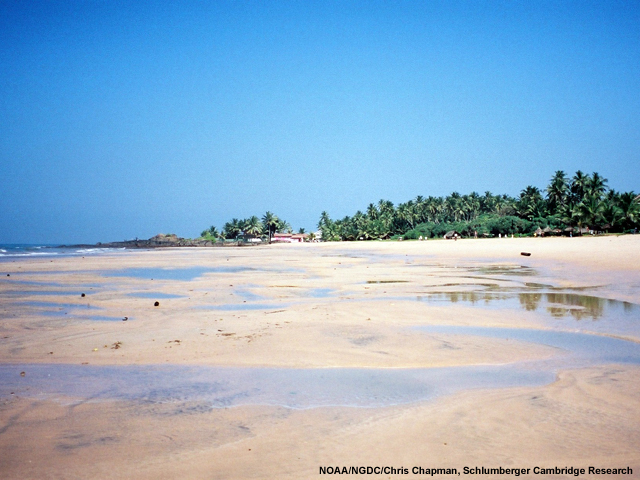
When tsunamis arrive, it is not usually as a single wave. There are multiple waves that arrive at unpredictable intervals, making the coastline dangerous for hours or days. And the first wave is often not the biggest.
Tsunamis can arrive crest-first or trough-first. When the trough comes first, the sea withdraws. Suddenly beach exists where there was no beach before. Stranded fish flop about and can lure curious but unwise beachgoers closer to danger.
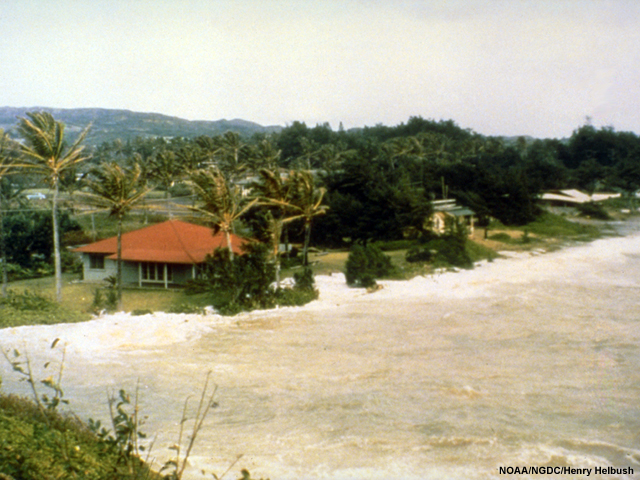
In the opposite case, the water usually advances in one of two ways: as a swiftly rising but sometimes otherwise innocuous-looking flood;
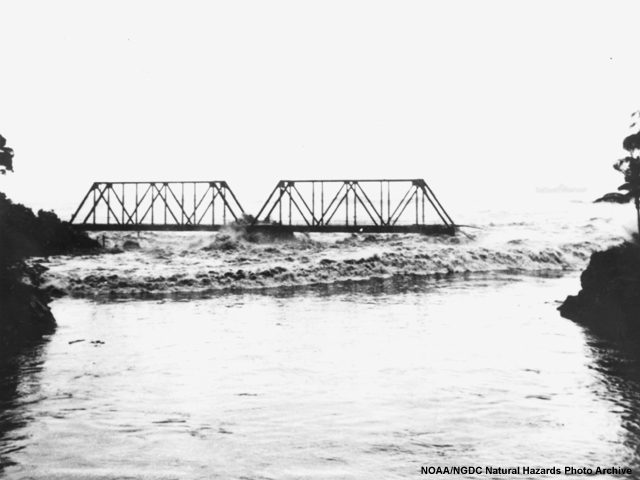
or as a single or series of stepped walls of water, similar to phenomena called tidal bores that occur in some rivers of the world. In either case, the flow of water that ultimately follows can far exceed anything produced by tidal forces.
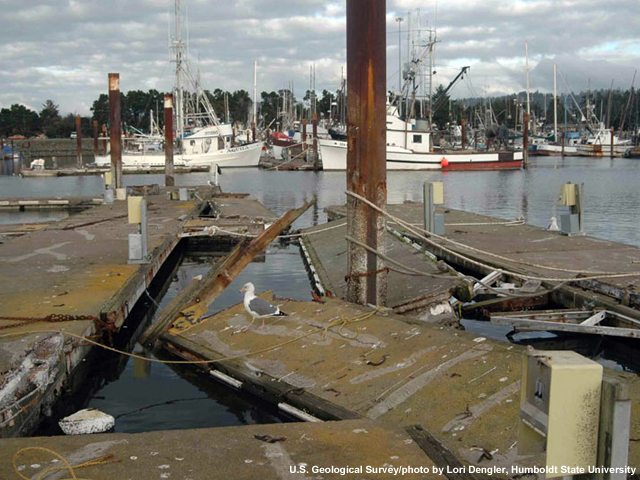
In the Kuril tsunami of 2006, the Crescent City, California, harbor remained placid and simply filled up. The harbormaster didn’t notice anything was wrong until he saw a buoy underwater and the docks buckling.
In the 2004 Indian Ocean tsunami, in some places the calm-looking sea rose quickly without warning.
Warning: This video contains graphic content. Viewer discretion is advised.
In other locations, the very same tsunami arrived as a furious surge.
Only occasionally does a tsunami arrive like a massive wall of curling water of the sort most people think of.
Why don't most tsunamis arrive this way?
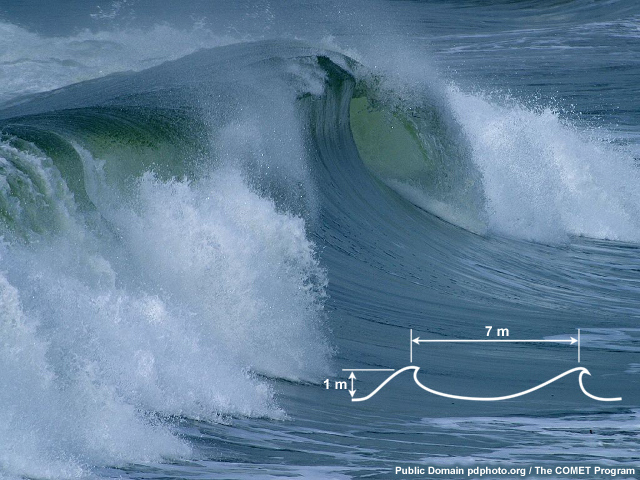
A breaking wave needs to be very steep: specifically, a minimum wave height to wavelength ratio of one to seven. But the wavelength of tsunamis is hundreds of kilometers or miles long. Though they do shorten as they approach shore, it is more difficult for the rising amplitude to reach the critical value given a tsunami’s wavelength.
Minor Inundation Effects
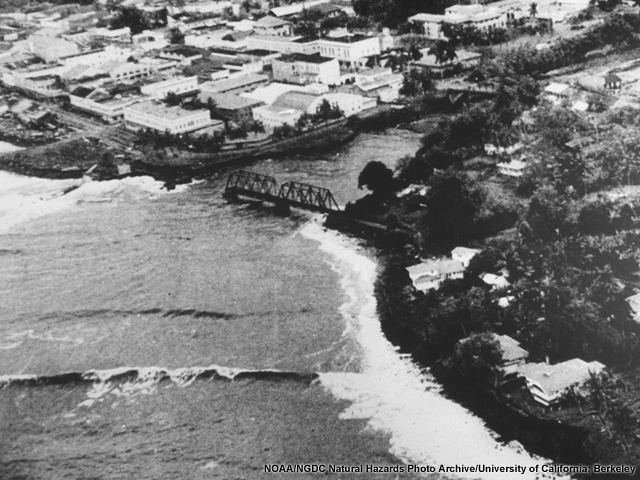
Many small, subtle variations work to complicate the behavior of tsunamis. These seemingly small details can determine how tsunamis behave in a big way. For example, the waves' behavior in one bay may be completely different from the next bay. Friction, non-linear effects, scouring, and addition effects all contribute to this.
Friction acts as a drag force that wears waves down. It doesn’t slow them directly, but instead drains their energy. Some of the energy is also lost through reflection back to the sea, further reducing wave energy at shore. In the deep ocean, friction has a negligible effect on tsunamis. During inundation, friction becomes extremely important. Vegetated or other rough surfaces increase friction, softening the impact on the shoreline.
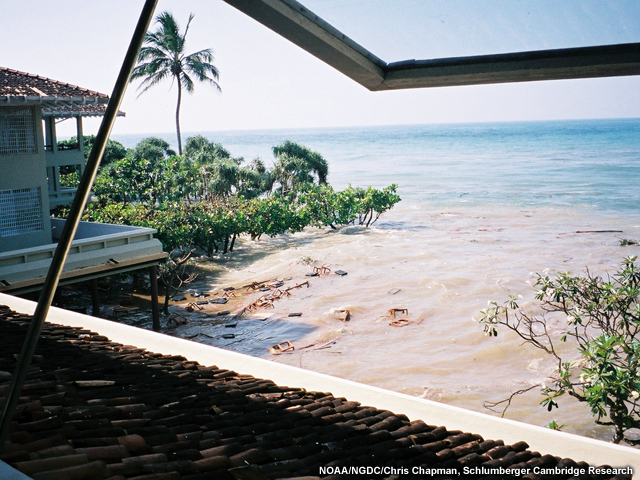
In shallow water, non-linear effects can generate additional waves with higher frequencies and shorter periods. These effects become important when wave height is comparable to water depth—that is, near shore. They may appear in many forms, like a rapidly rising tide or a tsunami bore.

Tsunami bores—stepped, rolling walls of water—often form after a large drawdown of sea level. They may be curved in the center if the ocean depth is not uniform. And they are turbulent and noisy, proof of their rapid shedding of wave energy. They froth and churn up sand, air, foam.
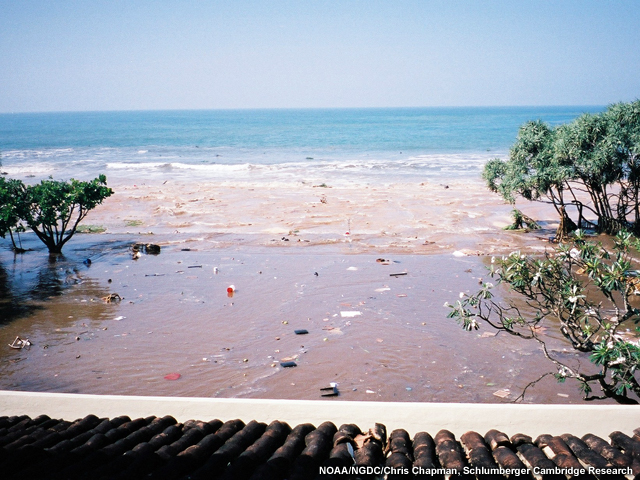
Scouring is another important inundation effect. High energy tsunamis often scour the impact zone, reshaping the landscape. The moving water accumulates fallen trees and debris, becoming a slurry that plunges down the freshly scoured seabed, often seriously eroding the land.
Tsunamis can also produce what scientists call addition effects, such as standing waves, sloshes, or whirlpools, which can appear as tsunamis turn and retreat.
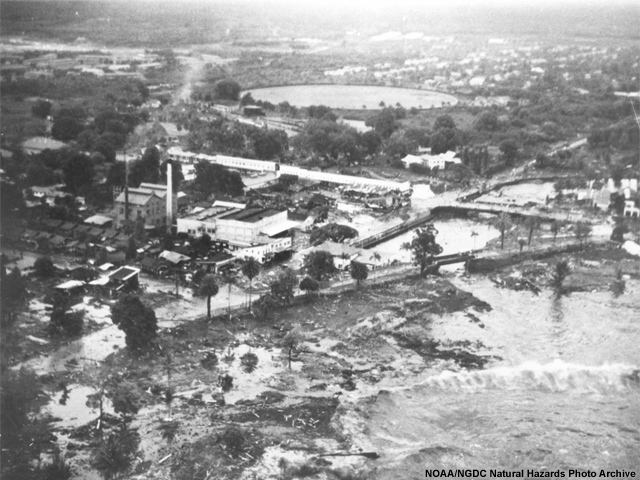
All of these effects are difficult to gauge, making tsunamis’ precise behavior at inundation unpredictable. Considering non-linear effects, three-dimensional water motions, complex friction patterns, and other complications, detailed tsunami behavior at inundation is near-impossible for scientists to model. This limits the ability to inform the public exactly what to expect.
Tides
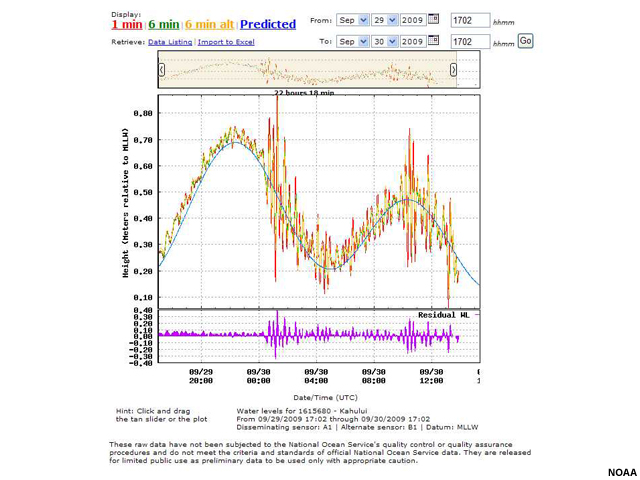
Tides can also influence inundation. When tsunamis arrive at high tide, this can bring greater flooding. Low tides present a different danger: ships may bottom out in harbors. Significant tsunami effects are likely to persist over both high and low tide cycles. It is thus difficult for tsunami forecast models to accurately predict tsunami heights after the first hour or two of impact.
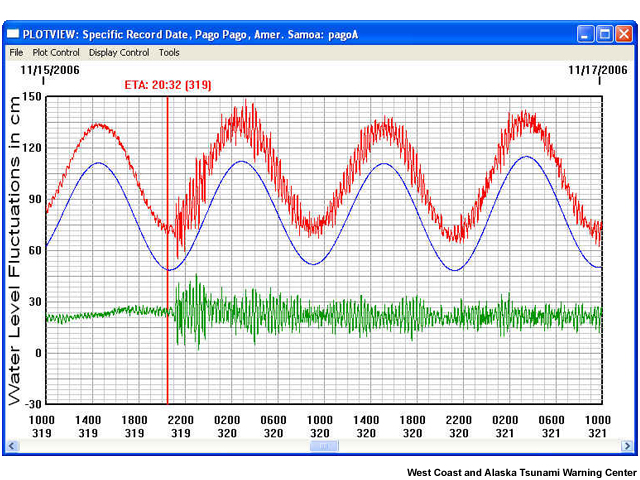
Tides are also important when scientists look at marigrams of tsunamis. They generally de-tide them by removing known tidal effects to isolate the tsunami. This is analogous to mean-sea-level pressure maps from which meteorologists remove pressure differences due to different land elevations so they can more clearly see the meteorological pressure differences.
Local Bathymetry and Coastal Orientation Effects
The shape of the ocean bottom and the coast can greatly affect inundation. In the example given in the propagation section, the Mendocino ridge, which is perpendicular to shore, focuses waves along its length due to refraction. This, in turn, focuses the waves toward a point on shore at the end of the ridge, creating a zone of higher inundation there. Wind waves wouldn't experience this effect because their wave motions don't extend to the bottom of the ocean in deep water as tsunamis' do, so this focusing would only be apparent during tsunamis and absent at other times. Coastal orientation can also affect inundation if a coastline is parallel to the fault that created the tsunami waves, and thus, to the brunt of “beamed” energy.
Bay and Inlet Resonance
The dimensions of a bay can also influence inundation when their oscillation modes, or resonant frequencies, are similar to the tsunami period. Think of a home aquarium shaken back and forth—if you shake it at the right frequency, the wave height will increase. This is called resonance. In this animation, you can see a similar effect.
If the length of a bay or inlet is the same as or a simple multiple of the wavelength of the tsunami—that is, if a whole number of wavelengths fit in the bay—the next wave in the series can reinforce the first by pushing at just the right moment, creating resonance and amplifying inundation.
This sloshing is called “seiching” or “seiche.” The same thing can happen if the period of the waves matches the time it takes for waves to travel the length of the bay and back. This is not uncommon. For instance, a harbor with a resonance of 15 to 30 minutes matches that of a typical tsunami wave period. If the second incoming tsunami wave pushes at just the right time, the waves are magnified. This happened in the Kuril tsunami of 2006 in Crescent City harbor.
Edge Waves
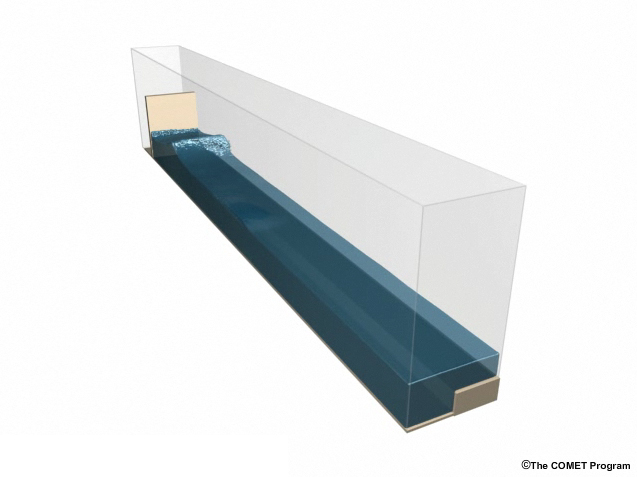
Click image to view animation. Note the slower and higher amplitude wave on the right side of the wave tank.
Tsunamis can be steered by drop-offs as well as by ridges. If a wave is moving parallel to the shore it may be guided by the drop-off of the continental shelf. Refraction along the shallow shelf slows and guides a wave down the coast. This was seen in the 1992 northern California earthquake, where a slower edge wave traveled down the coast of California.
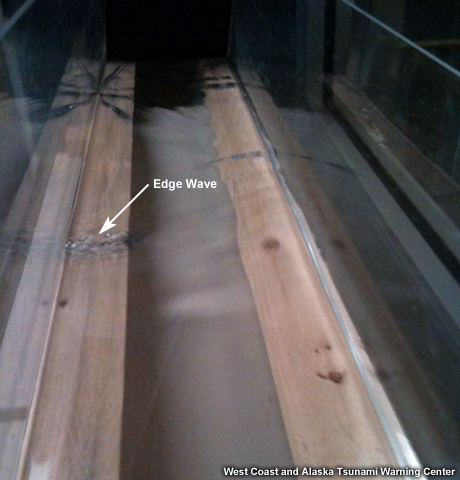
The same effect can be seen in wave tanks that simulate a continental shelf.
Refraction and edge waves can produce some interesting effects. For example, a wave that strikes the islands of Hawaii can wrap around them as they’re steered by the slope along the coastline. When it reaches the lee side of the island, the parted waves reunite and the inundation can be as high as it was on the other side of the island even though the wave is technically moving in the opposite direction. In this movie of the Kuril Island tsunami of 2006, pay particular attention to the southeast side of Oahu and the bay on the south side of Maui.
Shelf Trapping
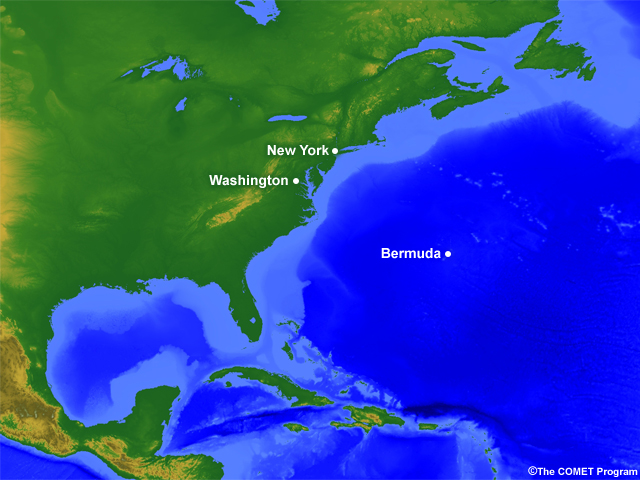
Of all tsunami inundation effects, shelf trapping is probably the most surprising. On the east coast of the United States, the continental shelf drops steadily to the abyssal plain. When a tsunami generated near Portugal, for example, encounters this shelf, the wave splits into reflected and transmitted waves. Then, when the transmitted wave strikes the east coast of the U.S., it reflects east as expected.
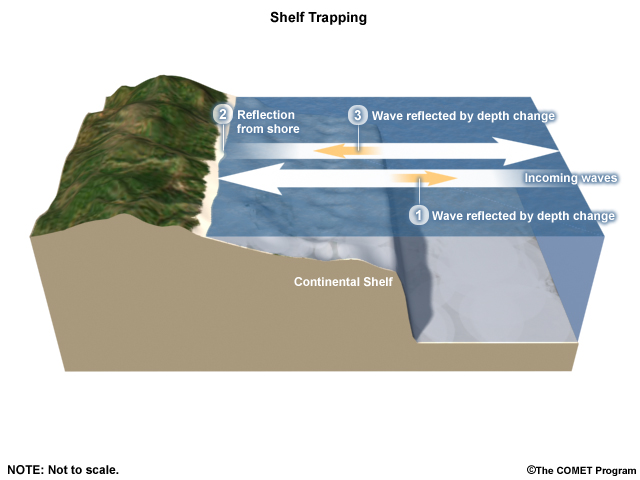
But then another interesting thing happens: the shelf drop-off splits the wave again, acting as a partial mirror that once again reflects part of the wave back toward shore. The wave can continue bouncing back and forth between shore and shelf edge for quite a while, an effect called shelf trapping.
Shelf trapping doesn't seem right because there isn't anything blocking waves at the end of the continental shelf. What is there is a sudden change in depth, and consequently, wave speed. Shelf trapping can only occur when the depth change is abrupt, that is, shorter than one wavelength long.
Since tsunamis have extremely long wavelengths, it’s easy for the edges of continental shelves to qualify, and the reflection happens no matter which way the waves are traveling when they encounter it. If you watch this model carefully, you will see that the dropoff at the 90,000 mark actually reflects a wave when it first encounters it and then again on the wave’s way back out, trapping a part of it on the shelf.
Summary Questions
Question 1
How does a tsunami wave become a rushing current of water? (Choose the best answer.)
The correct answer is B.
Question 2
Why do tsunamis initially have fixed periods when they approach shore? (Choose the best answer.)
The correct answer is B.
Question 3
Tsunamis always arrive by first withdrawing the water from shore. (Choose the best answer.)
False. Some tsunamis produce waves without warning before they withdraw water from the beach.
Question 4
(Use the selection box to choose the answer that best completes the statement.)
Most tsunamis do not arrive as a giant curling wave because it is difficult for them to reach the wave steepness needed for waves to break. This is because their wavelength is so large.
Question 5
How does friction affect waves? (Choose all that apply.)
The answers are C and D.
Question 6
What are the two chief tsunami-related tide dangers? (Choose all that apply.)
The answers are B and D.
Question 7
Tidal-bore-style tsunamis appear as a _________. (Choose the best answer.)
The correct answer is A. Tidal bore-style tsunamis appear as a wall or series of walls of churning water.
Question 8
Harbor resonance leads to amplification of a tsunami by successive tsunamis matching the natural frequency of a harbor. (Choose the best answer.)
True. Waves that push at just the right moment are said to be "in phase". Tsunamis can be amplified in this way within bays with natural resonance similar to the tsunami wavelength.
Question 9
Tsunamis that arrive on the north side of an island or peninsula can still impact coasts on the southern side due to this wave behavior. (Choose the best answer.)
The correct answer is D.
Question 10
Shelf trapping is a product of which of the following? (Choose all that apply.)
The answers are C and D. Sudden extreme depth changes act as a reflector for waves because they produce a sudden change in wave speed.
Runup
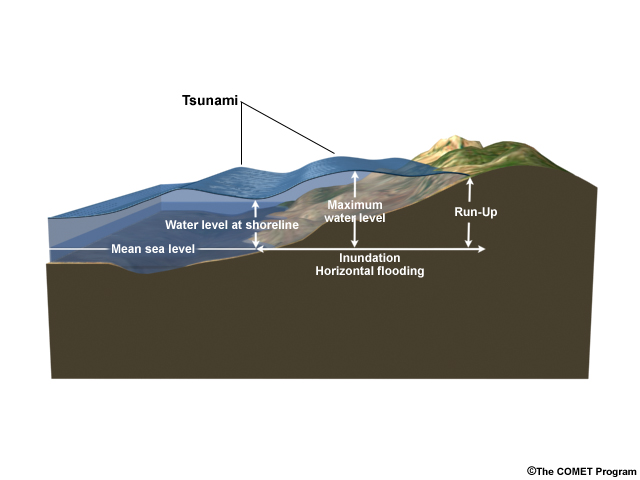
While inundation is the maximum horizontal wave extent, runup is the maximum wave elevation above ambient sea level. It may or may not be the same as the maximum water level.
Momentum
When waves reach the shoreline, the current, or forward momentum, is very large, and can often push the waves far higher than their height at sea. This is a result of the conservation of energy – waves increase in height in shallow water as a function of depth to conserve momentum. A wave that is 2 m (6.5 ft) high off shore may reach two to five times that height on shore. This amplification is referred to as Green’s Law.
This momentum can carry tsunamis far inland. Successive waves can push the water even higher and further ashore.
Force
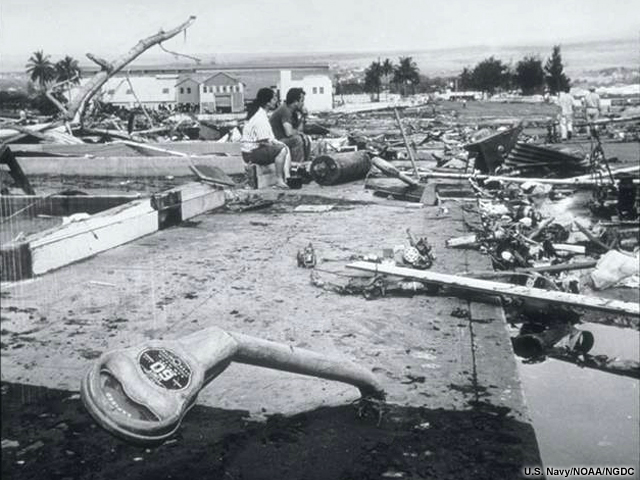
The pressure of an incoming wave depends on the square of current speed times the density of seawater. With the density of water at about 1,000 kg per cubic m (64 lb per cubic foot ), it doesn’t take a lot of current to do a lot of damage. When multiplied by the cross-sectional area, this is called the dynamic force of the wave—the force you might feel standing on a beach as a wave pushes against your legs.
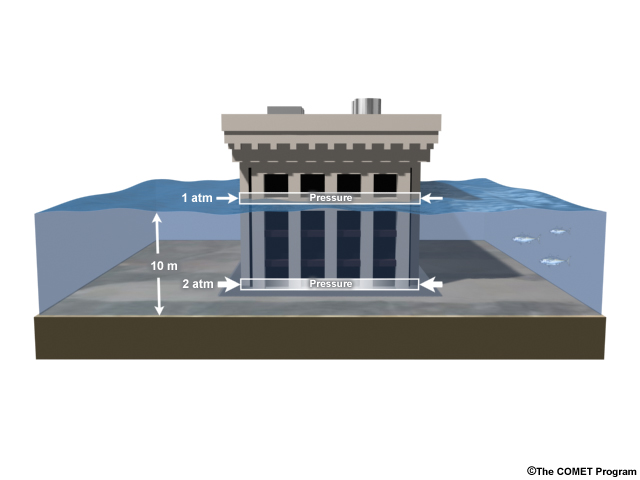
There is also a second force that incoming waves exert. This is called hydrostatic pressure, which is the force you feel on your ears when swimming at the bottom of a pool. If a wall of water strikes a building, the pressure at the bottom of the water column is greater than at the top. This force is strong enought to lift buildings off their foundations.
In reality, there are many other ways waves can damage structures.
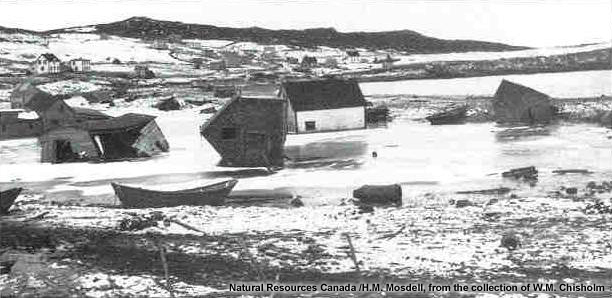
As mentioned in the section on minor inundation effects, waves running up the shore are unpredictable and can behave in surprising ways. Water might rise up under a building and lift it, an effect called the buoyancy force.
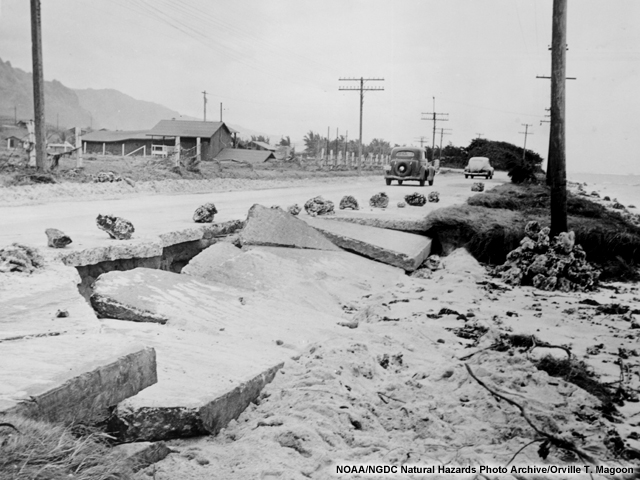
A retreating wave might scour or erode soil and undermine foundations, causing buildings, bridges, or seawalls to collapse.
A wave that wraps around a building may be more forceful on the back than the front because the water is funneled between buildings into smaller, more powerful streams that wrap around and meet. People who hide behind houses are in extra danger from this effect.
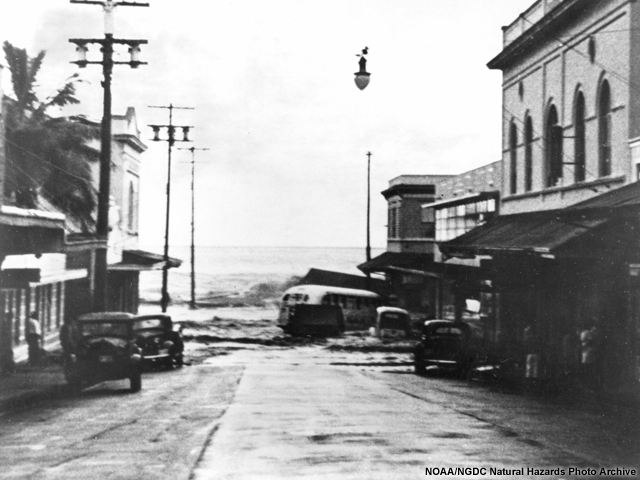
If homes stand in rows, the second row of houses may actually be hit harder by a tsunami wave than the first. The first row funnels the wave’s energy into smaller but stronger streams that blast the second row harder.
Outgoing Waves
What do you think? Outgoing waves are less dangerous than incoming waves because they are slower moving. (Choose the best answer.)
False. Tsunamis may be even more dangerous on the retreat because they are now loaded with debris, and can also be faster.
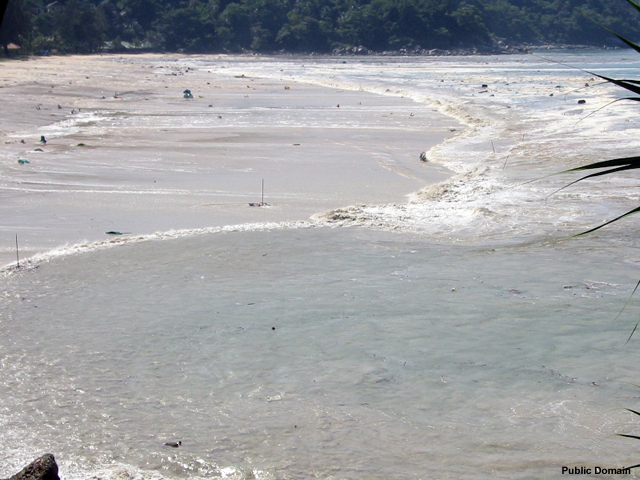
When a wave exhausts its momentum and turns back to sea, it can grow even more dangerous. Like a tornado, a tsunami that strikes a city, particularly on its retreat, is armed with debris and accordingly more dangerous. Outflow, or run-down, velocity can also be greater than the initial inundation speed since there may be new scour channels that funnel the return flow.
Bays and Rivers
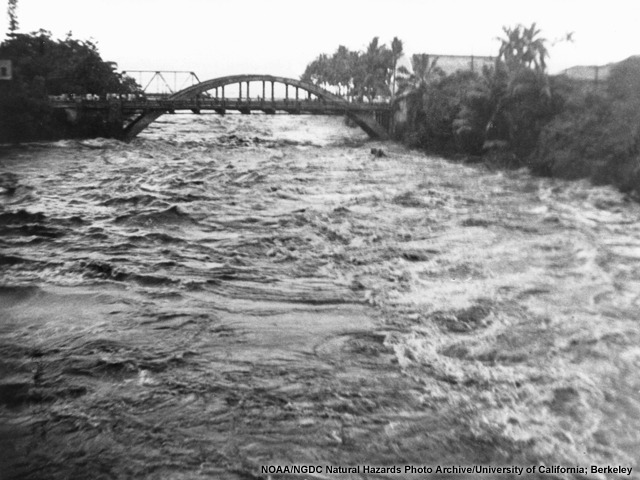
In bays and rivers, tsunamis can surge far inland. The low elevation water found in rivers and wetlands makes them ideal for funneling tsunamis upstream. In Banda Aceh during the 2004 Indian Ocean tsunami, the inundation followed watersheds and river channels far upstream—up to three miles—as the waves sought the path of least resistance. In the 1964 Alaska tsunami, a wave went 65 km (40 mi) up a narrow inlet near Tofino, British Columbia. Deposits of beach sand carried by ancient tsunamis have been found over 112 km (more than 70 mi) up the Columbia River separating Oregon and Washington.
Summary Questions
Question 1
In general, what causes waves to travel higher up on shore than their heights at sea? (Choose all that apply.)
The answers are A and C. Momentum and shallow water combine to produce waves that increase in height and travel much higher up the shore than the waves were at sea.
Question 2
Which of the items below are physical forces that cause damage on shore when a tsunami strikes? (Choose all that apply.)
The answers are A, B, and D.
Question 3
Bays and rivers dampen the movement of tsunamis by containing them in smaller areas. (Choose the best answer.)
False. Bays and rivers can funnel the energy of a tsunami leading it to travel far inland.
Summary Interaction
Question 1
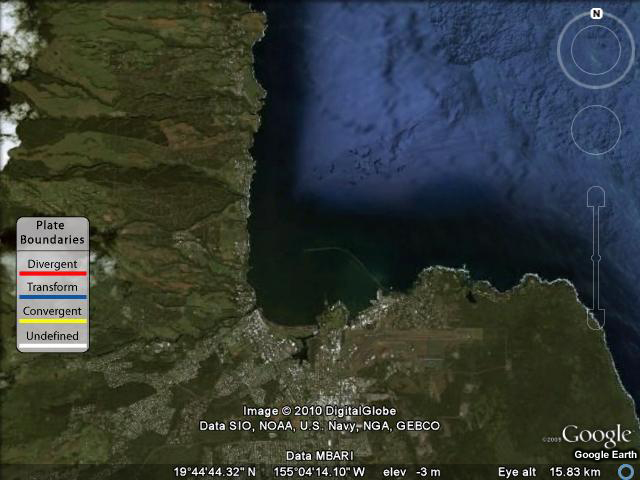
Which of the following tsunami wave effects might be observed in this image? (Choose all that apply.)
The correct answer is D. This is Hilo Bay, Hawaii. This bay is notorious for causing large, long runups thanks to its shallow bottom and funnel shape. Its breakwater wall could cause resonance.
Question 2
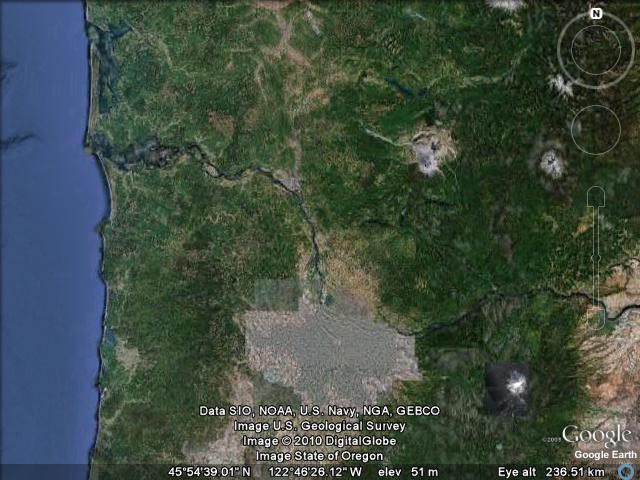
Which of the following tsunami wave effects might be observed in this image? (Choose all that apply.)
The correct answer is D. This is the Columbia River in the northwest United States. Long rivers can have long runups in their channels.
Question 3

Which of the following tsunami wave effects might be observed in this image? (Choose all that apply.)
The correct answers are B and C. Here on the coast of Peru, the continental shelf provides ample opportunity for shelf trapping and edge waves.
Question 4
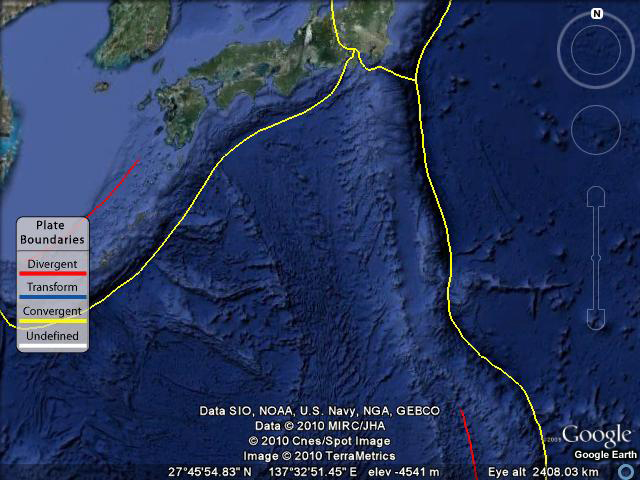
Which of the following tsunami wave effects might be observed in this image? (Choose all that apply.)
The correct answers are A, B, C, and D. The long ridges evident in this image of the seafloor off southeast Japan can focus waves on shore. The bit of continental shelf off the coast could also cause shelf trapping or edge waves. In addition, the many bays could be susceptible to large, long runups.
Question 5

Which of the following tsunami wave effects might be observed in this image? (Choose all that apply.)
The correct answer is E. This is the Antarctic ice shelf. There are no obvious features in this image that would cause any of the listed wave effects.
